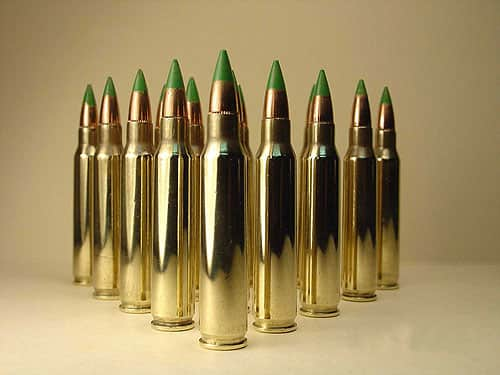ATF Proposal Would Ban Common AR-15 Ammo
Matt Korovesis 02.16.15

Last week, the Bureau of Alcohol, Tobacco, Firearms and Explosives (ATF) announced that it planned to implement a modified regulatory framework for determining whether a projectile is considered “armor piercing” handgun ammunition. This new framework would effectively ban 5.56x45mm M855 ball munitions, a common type of ammo used in AR-15-pattern firearms.
The ATF’s proposal is detailed in a document titled “Framework for Determining Whether Certain Projectiles are ‘Primarily Intended Purposes’ Within the Meaning of 18 U.S.C. 921(a)(17)(c).” A federal law passed in 1986 prohibits the manufacture, importation, and sale of so-called “armor piercing” handgun projectiles. Pursuant to the 1986 law, the ATF defines “armor piercing ammunition” as:
- A projectile or projectile core which may be used in a handgun and which is constructed entirely (excluding the presence of traces of other substances) from one or a combination of tungsten alloys, steel, iron, brass, bronze, beryllium copper, or depleted uranium; or
- A full jacketed projectile larger than .22 caliber designed and intended for use in a handgun and whose jacket has a weight of more than 25 percent of the total weight of the projectile.
Despite the fact that M855 does not have a core made entirely of the materials listed under the ATF’s definition of “armor piercing ammunition” (it features a lead core with a steel tip), it was still deemed “armor piercing” as it could be used in certain handguns. However, the ATF assigned a special “primarily intended for sporting purposes” exemption to M855 and allowed it to continue to be commercially manufactured, imported, and sold.
The National Rifle Association’s Institute for Legislative Action (NRA-ILA) pointed out that the new framework would get rid of M855’s exemption and effectively prevent the sporting purposes exemption from being applied to other common types of 5.56 ammunition. The ATF would only apply exemptions to two types of ammo under the new framework:
- Category I: .22 Caliber Projectiles: A .22 caliber projectile that otherwise would be classified as armor piercing ammunition under 18 U.S.C. 921(a)(17)(B) will be considered to be “primarily intended to be used for sporting purposes” under section 921(a)(17)(C) if the projectile weighs 40 grains or less AND is loaded into a rimfire cartridge.
- Category II: All Other Caliber Projectiles: Except as provided in Category I (.22 caliber rimfire), projectiles that otherwise would be classified as armor piercing ammunition will be presumed to be “primarily intended to be used for sporting purposes” under section 921(a)(17)(C) if the projectile is loaded into a cartridge for which the only handgun that is readily available in the ordinary channels of commercial trade is a single shot handgun. ATF nevertheless retains the discretion to deny any application for a “sporting purposes” exemption if substantial evidence exists that the ammunition is not primarily intended for such purposes.
NRA-ILA deemed the proposal “a move clearly intended by the Obama Administration to suppress the acquisition, ownership and use of AR-15s and other .223 caliber general purpose rifles, […] The decision continues Obama’s use of his executive authority to impose gun control restrictions and bypass Congress.”
“Green tip” ammo, as M855 is commonly known, is popular among shooters for its affordability and reliable performance. The 62-grain M855 load is manufactured in massive quantities in the United States and abroad.
The departure of a plentiful and cheap 5.56 round from the market would likely lead to increased ammo prices across the board. Many online ammo retailers’ stocks of M855 were sold out within hours of the ATF’s announcement. The proposal would not make possession of M855 ammunition illegal.
The ATF is accepting comments on its proposal through March 16, 2015. Comments on the framework can be submitted via email to apacomments@atf.gov.
Note added 2-22: The text of this article has been clarified to explain why M855 should not be restricted under the ATF’s original “metal construction” guideline.

